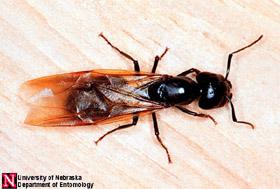Carpenter Ants
go.ncsu.edu/readext?809962
en Español / em Português
El inglés es el idioma de control de esta página. En la medida en que haya algún conflicto entre la traducción al inglés y la traducción, el inglés prevalece.
Al hacer clic en el enlace de traducción se activa un servicio de traducción gratuito para convertir la página al español. Al igual que con cualquier traducción por Internet, la conversión no es sensible al contexto y puede que no traduzca el texto en su significado original. NC State Extension no garantiza la exactitud del texto traducido. Por favor, tenga en cuenta que algunas aplicaciones y/o servicios pueden no funcionar como se espera cuando se traducen.
Português
Inglês é o idioma de controle desta página. Na medida que haja algum conflito entre o texto original em Inglês e a tradução, o Inglês prevalece.
Ao clicar no link de tradução, um serviço gratuito de tradução será ativado para converter a página para o Português. Como em qualquer tradução pela internet, a conversão não é sensivel ao contexto e pode não ocorrer a tradução para o significado orginal. O serviço de Extensão da Carolina do Norte (NC State Extension) não garante a exatidão do texto traduzido. Por favor, observe que algumas funções ou serviços podem não funcionar como esperado após a tradução.
English
English is the controlling language of this page. To the extent there is any conflict between the English text and the translation, English controls.
Clicking on the translation link activates a free translation service to convert the page to Spanish. As with any Internet translation, the conversion is not context-sensitive and may not translate the text to its original meaning. NC State Extension does not guarantee the accuracy of the translated text. Please note that some applications and/or services may not function as expected when translated.
Collapse ▲
Carpenter ant queen.
Dept. of Entomology, University of Nebraska
It is common to have questions concerning carpenter ants. Carpenter ant nests are usually constructed in wood that is soft enough for them to create galleries for rearing young and to expand to accommodate a colony size of several thousand individuals. Outside they can nest in firewood piles or in trees that have been softened by rot, but they can invade homes.
They do not eat the wood, but chew it and push it out so you may see small piles of sawdust. They often infest wood that has some moisture damage, because it is easy to work in. They can and do infest wood that appears sound and without moisture damage. Carpenter ants feed on a variety of foods, and the workers will forage considerable distances to find what they need. They are often seen climbing trees in search of aphids and other insects to feed on. An important aspect of carpenter ant biology is
that in the spring the worker ants will usually be encountered foraging during the day. By late summer, carpenter ants conduct most of their foraging activity at night and can go unnoticed. Homeowners often see these ants in the spring, around the dishwasher and sink.
Control of carpenter ants requires a little time, a little work, and a little luck! The main nest site must be located and removed or insecticide applied. In houses, the main nest site may be associated with moisture-damaged wood. So, the first step should be to think where wood in and around the house might be exposed to excessive moisture. This is usually under the dishwasher, sink, or bathtub or around a door or window. Although carpenter ants do make trails, they are not easy to find, so there is little chance of following an ant back to the nest. If you noticed ants in the house in the early, cooler part of spring, the nest is probably in the house. Inspect the framework of the house for nests and when found, replace the damaged wood. This will take care of the ants as well. If there is only a small nest, a residual insecticide can be applied to the area where the nest is found.
In the home, bait stations containing bait, which the ants carry back to their nest, work fairly well. These can be bought at garden centers, farm and hardware stores, and some grocery stores. The workers take the bait back to the nest and feed it to the other ants and this slowly kills the nest. It may take several days, but will work in many cases. If you find that one brand doesn’t seem to work, you might try another brand and it may be more effective. These bait stations should not be placed in areas where children and pets may handle them, because they do contain pesticides. Contact insecticides sprayed around the home are not usually very effective and therefore not recommended.
There are several ants that can invade homes, so if you have questions or need to have an ant, insect, or plant disease problem identified, give me a call at 704-283-3729.




